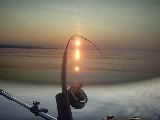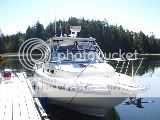For those thinking of running out and getting those manual operated EPIRB and attaching, or sticking them in their pockets – good luck! Doing that, will an EPIRB make the outcome any different – maybe, maybe not… but only if it is a “floating” on the surface and I don't think I will be betting my life on that one. Then, one needs to understand the response time capabilities (based on weather and position), even if it does go off response times can vary greatly. Time in any water is critical!
FYI… unless things have changed? During normal work “DAY” hours, we had a committed 30 minute to launch time. After normal duty hours and on weekends, unless a specific mission dictated otherwise – the committed “SAR” launch time was TWO HOURS. That is two hours from notification, to launch from our airfield. I believe if you check Canada Forces will have the same requirements, as I very much cross- trained with Canadian pilots – but things do change?
My primary aircraft at that time for that mission was the CH-47D Chinook, referred as the CH-147D Chinook in Canada. They are the same aircraft with very few modifications. Each aircraft was equipped with an ‘Automatically Deployable Emergency Locator Transmitter’ (ADELT) and both Pilots carried separate/individual portable Emergency Survival Radios, so each aircraft was equipped with a minimum of THREE what is now being referred to as ‘Emergency Position Indicating Radio Beacons’ (EPIRBs) for marine use. That should tell you – they work! But, they are only PART of SURVIVAL gear needed that will make a difference! The very last thing I always put on before any mission was my individual ‘survival vest’, which was required for our missions and worn by all crew members. On missions over water, we were required to wear individual ‘water wings’ and carry ‘Life Raft Kits’, which included survival gear for the appropriate number of personnel on board the aircraft.
EPIRB’s save lives – that is proven! If you chose to get one - get a good one, as your life is going to depend on it - it very well could. Transport Canada requires a “free floating” EPIRB for a reason – those things just don’t seem to transmit very well under water. Then, remember you still have that response time (based on weather and position). If "I" had to make a choice offshore, in the fog, with no other vessels around...I would not only be looking at a good offshore PFD, but would be buying a GOOD automatically deployable - LIFE RAFT! Life rafts don't work very well when tied down to an upside down boats, either! I personally don't care if I am picked up in 30 minutes or 30 hours if in a nice comfortable GOOD life raft, but with the additional use of an EPIRB and located in three hours rather than that 30 hours sounds a little better, doesn't it? However, last thing and what I do NOT want is bob around in that cold water for any length of time just waiting for someone to respond to a radio beacon! The most importand and first thing...
I WANT OUT OF THAT WATER - AND I WANT OUT FAST!
Now, while there are times a U.S. and/or Canada military helicopter can and will be diverted from one mission to respond to a ‘life threatening’ emergency – DON”T count on it! Unless that helicopter just happens to be close, happens to have the hoist and other equipment on board and installed, and your Gods are really with you… as a helicopter already half way through another mission will probably NOT have the fuel! That is one reason there is dedicated SAR helicopters on standby! And, it is really tricky for a fixed wing aircraft to do the rescue part of that mission 20 miles offshore and I really can’t see them landing in 15 foot swells? I guess they could drop a life raft, which you should already have as part of your survival gear?
Finally, the coastal waters have been divided into two SAR areas. A DFO/CCG patrol vessel is continuously stationed in each zone to provide SAR coverage. That is the first normally utilized to respond, depending on the circumstances it won’t be any aircraft if a surface vessel is close. I assure you, neither Joint Recue Co-ordination Centre Victoria (JRCC) nor the U.S. Coast Guard District 13 (RCC), or any other JRCC or RCC is going to launch SAR aircraft upon receiving a distress radio beacon. Sorry it just doesn’t work that way, they don’t – they will try contacting to verify first. Usually by VHF or cell phone, then if no contact is made, they will call the contact information, the alternate contact information, and any phone numbers listed on the registration! After that, if an emergency if believed or confirmed, comes the Pan Pan calls– they will then contact the appropriate support units to launch the appropriate SAR units.
Again, sorry but that is the way it is – If you want to run offshore and still have a chance of survival if something happens, an EPIRB would be a good thing to have, but you really need to also - BUY A “GOOD” LIFE RAFT!
http://www.ccg-gcc.gc.ca/e0003868






